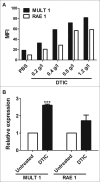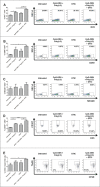Poly(I:C) and CpG-ODN combined aerosolization to treat lung metastases and counter the immunosuppressive microenvironment
- PMID: 26451303
- PMCID: PMC4589046
- DOI: 10.1080/2162402X.2015.1040214
Poly(I:C) and CpG-ODN combined aerosolization to treat lung metastases and counter the immunosuppressive microenvironment
Abstract
The immunostimulatory ability of synthetic oligonucleotides containing CpG motifs (CpG-ODN), agonists of Toll-like receptor 9 (TLR9), can be harnessed to promote antitumor immunity by their application at the tumor site to stimulate local activation of innate immunity; however, particularly in the lung, tumor-associated immunosuppression can subvert such antitumor innate immune responses. To locally maintain continuous activation of innate subpopulations while inhibiting immunosuppressive cells, we evaluated aerosol delivery CpG-ODN combined with Poly(I:C), a TLR3 agonist able to convert tumor-supporting macrophages to tumoricidal effectors, in the treatment of B16 melanoma lung metastases in C57BL/6 mice. Aerosolization of CpG-ODN with Poly(I:C) into the bronchoalveolar space reduced the presence of M2-associated arginase- and IL-10-secreting macrophages in tumor-bearing lungs and increased the antitumor activity of aerosolized CpG-ODN alone against B16 lung metastases without apparent signs of toxicity or injury of the bronchial-bronchiolar structures and alveolar walls. Moreover, CpG-ODN/Poly(I:C) aerosol combined with dacarbazine, a therapeutic agent used in patients with inoperable metastatic melanoma able to exert immunostimulatory effects, led to a significant increase in antitumor activity as compared to treatments with aerosolized CpG-ODN/Poly(I:C) or dacarbazine alone. This effect was related to an enhanced recruitment and cytotoxic activity of tumor-infiltrating NK cells in the lung. Our results point to aerosol delivery as a convenient approach for repeated applications of immunostimulants in patients with lung metastases to maintain a continuous local activation of innate immune cells while suppressing polarization of tumor-infiltrating macrophages to an M2 phenotype.
Keywords: TLR agonists; aerosol delivery; dacarbazin; lung metastases; mice.
Figures






Similar articles
-
Reprogramming the lung microenvironment by inhaled immunotherapy fosters immune destruction of tumor.Oncoimmunology. 2016 Sep 20;5(11):e1234571. doi: 10.1080/2162402X.2016.1234571. eCollection 2016. Oncoimmunology. 2016. PMID: 27999750 Free PMC article.
-
Anti-tumor activity of CpG-ODN aerosol in mouse lung metastases.Int J Cancer. 2013 Jul 15;133(2):383-93. doi: 10.1002/ijc.28028. Epub 2013 Feb 12. Int J Cancer. 2013. PMID: 23319306
-
Activation of NK cell cytotoxicity by aerosolized CpG-ODN/poly(I:C) against lung melanoma metastases is mediated by alveolar macrophages.Cell Immunol. 2017 Mar;313:52-58. doi: 10.1016/j.cellimm.2017.01.004. Epub 2017 Jan 5. Cell Immunol. 2017. PMID: 28089340
-
Immunostimulatory Activities of CpG-Oligodeoxynucleotides in Teleosts: Toll-Like Receptors 9 and 21.Front Immunol. 2019 Feb 8;10:179. doi: 10.3389/fimmu.2019.00179. eCollection 2019. Front Immunol. 2019. PMID: 30800129 Free PMC article. Review.
-
[Cancer immunotherapy with CpG-ODN].Med Sci (Paris). 2005 Jan;21(1):73-7. doi: 10.1051/medsci/200521173. Med Sci (Paris). 2005. PMID: 15639024 Review. French.
Cited by
-
Exploiting poly(I:C) to induce cancer cell apoptosis.Cancer Biol Ther. 2017 Oct 3;18(10):747-756. doi: 10.1080/15384047.2017.1373220. Epub 2017 Sep 7. Cancer Biol Ther. 2017. PMID: 28881163 Free PMC article. Review.
-
Promotion of epithelial-mesenchymal transformation by hepatocellular carcinoma-educated macrophages through Wnt2b/β-catenin/c-Myc signaling and reprogramming glycolysis.J Exp Clin Cancer Res. 2021 Jan 6;40(1):13. doi: 10.1186/s13046-020-01808-3. J Exp Clin Cancer Res. 2021. PMID: 33407720 Free PMC article.
-
Local Administration of Caloric Restriction Mimetics to Promote the Immune Control of Lung Metastases.J Immunol Res. 2019 Jun 20;2019:2015892. doi: 10.1155/2019/2015892. eCollection 2019. J Immunol Res. 2019. PMID: 31321243 Free PMC article.
-
Aerosol 1,25-dihydroxyvitamin D3 supplementation: A strategy to boost anti-tumor innate immune activity.PLoS One. 2021 Mar 29;16(3):e0248789. doi: 10.1371/journal.pone.0248789. eCollection 2021. PLoS One. 2021. PMID: 33780475 Free PMC article.
-
Methylation Regulation of TLR3 on Immune Parameters in Lung Adenocarcinoma.Front Oncol. 2021 May 20;11:620200. doi: 10.3389/fonc.2021.620200. eCollection 2021. Front Oncol. 2021. PMID: 34094905 Free PMC article.
References
-
- Adams S. Toll-like receptor agonists in cancer therapy. Immunotherapy 2009; 1:949-64; PMID:20563267; http://dx.doi.org/10.2217/imt.09.70 - DOI - PMC - PubMed
-
- Cheever MA. Twelve immunotherapy drugs that could cure cancers.Immunol Rev 2008; 222:357-68; PMID:18364014; http://dx.doi.org/10.1111/j.1600-065X.2008.00604.x - DOI - PubMed
-
- Hofmann MA, Kors C, Audring H, Walden P, Sterry W, Trefzer U. Phase 1 evaluation of intralesionally injected TLR9-agonist PF-3512676 in patients with basal cell carcinoma or metastatic melanoma. J Immunother 2008; 31:520-7; PMID:18463532; http://dx.doi.org/10.1097/CJI.0b013e318174a4df - DOI - PubMed
-
- Link BK, Ballas ZK, Weisdorf D, Wooldridge JE, Bossler AD, Shannon M, Rasmussen WL, Krieg AM, Weiner GJ. OligodeoxynucleotideCpG 7909 delivered as intravenous infusion demonstrates immunologic modulation in patients with previously treated non-Hodgkin lymphoma. J Immunother 2006; 29:558-68PMID:16971811; http://dx.doi.org/10.1097/01.cji.0000211304.60126.8f - DOI - PubMed
-
- De Cesare M, Calcaterra C, Pratesi G, Gatti L, Zunino F, Ménard S, Balsari A. Eradication of ovarian tumor xenografts by locoregional administration of targeted immunotherapy. Clin Cancer Res 2008; 14:5512-8; PMID:18765543; http://dx.doi.org/1995296010.1158/1078-0432.CCR-08-0445 - DOI - PubMed
Publication types
LinkOut - more resources
Full Text Sources
Other Literature Sources
Research Materials
